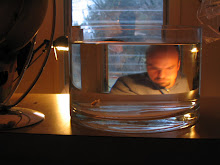
One of the oddest things about being a new parent is the fact that while your central concern is now the welfare of a baby, it's nevertheless rather hard to gauge that baby's health. Even the most alert four-week-old infant won't offer much of a response to the sincerest "How are you today?" Instead, what you get is a series of indirect signs and clues. And so every new parent becomes a sort of diviner, staring at the poop in a diaper or listening to the pitch of a cry with all of the focus of an ancient Babylonian priest trying to interpret the internal organs of a sheep.
Given this aura of uncertainty, visits to the pediatrician's office become, as academics like to say, overdetermined. The baby's placed on a scale, a weight's announced, and suddenly you can think of the baby's progress in concrete terms. But it's not done there; the doctor then quickly graphs the weight, and announces a percentile; now you can compare Cleo to all of the other month-old children out there, as well. It's an exhilarating process if it goes reasonably well: all of the hard work of several weeks of parenting can seem validated by a few numbers. And if the numbers are less than positive? I imagine that that might feel devastating, even if the baby seems to be quite happy in other directions.
So while a visit to the pediatrician does put a temporary end to all of the fretting and self-doubt that occurs in a normal week (Does the baby sleep too much? Is she eating enough? Should she be raising her head by now?), it's something of a double-edged sword. And, in thinking about that over the past few days, I realized that visits to the pediatrician are something like essays by aestheticians who try to establish firm criteria in discussing works of art. For example, take Bennett Reimer's essay "Criteria for Quality in Music," which is relatively typical of its field. It's a well-intentioned piece that tries to cast aesthetic judgment as consisting of four basic decisions (involving craftsmanship, sensitivity, imagination, and authenticity). Reimer is like the parent, in other words, who tries to think of the health of a baby in simple, quantifiable terms.
And perhaps it's meaningful, therefore, that such essays usually leave me cold and unconvinced. Certainly sensitivity and imagination must be related to our concepts of quality. But I never feel, after reading such essays, that they've gotten it exactly right. Kant's notion of the beautiful is stimulating, but it doesn't quite explain what I feel when I look at a Titian. And Joseph Margolis offers interesting reflections on aesthetic judgment, but his terms always feel a little too stiff, a bit too clinical.
In short, perhaps the beauty of a sonata and a baby's health are simply more complicated than a few pages can accommodate. We may desire, occasionally, the pat approach, and I'm sure that percentiles have their place in generally estimating a baby's physical welfare. But let's don't rely too much on them. Happiness, happily, cannot simply be measured in ounces, or inches.




No comments:
Post a Comment